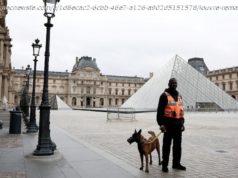The 2017 Atlantic hurricane season has proven to be active and deadly. Powerful hurricanes, like Harvey, Irma and Maria are also providing a testing ground for new tools that scientists hope will save lives by improving forecasting.
The 2017 Atlantic hurricane season has proven to be active and deadly. Powerful hurricanes, like Harvey, Irma and Maria are also providing a testing ground for new tools that scientists hope will save lives by improving forecasting. San Juan’s radar went down at 5:50 a.m. EDT, just before Maria made landfall on the island, and the land-based radar used during storms to provide detailed information on hurricane wind fields, rain intensity, storm position, and movement was lost. With this critical technology disabled and a major hurricane approaching, forecasters were able to utilize data from NOAA’s latest geostationary satellite, GOES-16 – tracking the storm in real-time. It is no wonder the GOES-16 satellite is winning praise with scientists. Some of the new technology debuting this year After the Hurricane Sandy fiasco in 2012, Congress ended up allocating „Our supercomputer investment over the past years has been substantial,“ Novak said. That investment over the past two years has given them three-times more processing power, which increases the speed of computations for more and more accurate forecasts. NOAA’s GOES-16 satellite captured this imagery of Hurricane Maria, now moving toward the Turks and Caicos Islands on September 21,2017. Funds went to an improved supercomputer that includes more observational data points and a This one platform alone will lead to improving forecasts for hurricane paths because its fine-scaled predictions feed immediately into the model’s next run, rather than lagging behind. Another tool used in forecasting hurricanes this year is NASA’s constellation of eight identical microsatellites, called the Cyclone Global Navigation Satellite System (CYGNSS). The satellites were launched on December 16,2016, and work by detecting the surface roughness of the ocean, a proxy for wind speed, from the reflected radio signals of GPS satellites. The CYGNSS array has made it possible to double coverage of hurricanes and other weather events around the world. NOAA’s GOES16 satellite captured this colorized-infrared imagery of Hurricane Maria over Puerto Rico on September 20,2017. The CYGNSS satellite array and the VF3 computer simulation modeling platform have gotten a workout this season. thanks to an unusually ferocious series of storms. GOES-16 is the clear winner this year The GOES-16 is able to scan a targeted area of severe weather as often as every 30 seconds, a capability not available with current GOES. This rapid scanning rate is allowing forecasters to analyze cloud patterns and track a hurricane in real time. NOAA GOES-16 Satellite captured this geocolor imagery of Hurricane Maria making landfall on Puerto Rico on the morning of September 20th. The National Hurricane Center reported (at 8:00 EDT) that Maria’s maximum sustained winds were near 150 mph with higher gusts, and that hurricane-force winds extended outward up to 60 miles from the storm’s center. GOES-16 also has three times more channels than the current GOES imagery, and four-times the resolution, providing better estimates of the structure of tropical cyclones and their environments, including data on wind speeds and water temperatures delivered every minute that is then fed into models. “It’s giving unparalleled details about the hurricanes,“ says Brian Tang, an atmospheric scientist at the University at Albany in New York, “I found that remarkable,” he says. “Ten or so years ago that wouldn’t have been possible.” GOES-16 will become GOES-EAST in November, once it becomes fully operational. “GOES-16 will be placed in the east position where it can observe the entire continental U. S., and monitor areas most vulnerable to tornadoes, floods, land-falling tropical storms, hurricanes and other severe storms,” said Stephen Volz, Ph. D., director, NOAA’s Satellite and Information Service. Even though the satellite was not yet operational, data from NOAA’s GOES-16 satellite proved vital in forecasting operations for Hurricane Maria as it neared Puerto Rico on September 20,2017. San Juan’s radar went down at 5:50 a.m. EDT, just before Maria made landfall on the island, and the land-based radar used during storms to provide detailed information on hurricane wind fields, rain intensity, storm position, and movement was lost. With this critical technology disabled and a major hurricane approaching, forecasters were able to utilize data from NOAA’s latest geostationary satellite, GOES-16 – tracking the storm in real-time. It is no wonder the GOES-16 satellite is winning praise with scientists. After the Hurricane Sandy fiasco in 2012, Congress ended up allocating nearly $80 million to the National Weather Service to help in funding improved technologies. According to David Novak, director of the agency’s Weather Prediction Center, the money was spent on a number of projects, including the agency’s supercomputers.“Our supercomputer investment over the past years has been substantial,“ Novak said. That investment over the past two years has given them three-times more processing power, which increases the speed of computations for more and more accurate forecasts. Funds went to an improved supercomputer that includes more observational data points and a new computer storm prediction platform called VF3 that can be run along with global weather simulation models. This one platform alone will lead to improving forecasts for hurricane paths because its fine-scaled predictions feed immediately into the model’s next run, rather than lagging behind. Another tool used in forecasting hurricanes this year is NASA’s constellation of eight identical microsatellites, called the Cyclone Global Navigation Satellite System (CYGNSS). The satellites were launched on December 16,2016, and work by detecting the surface roughness of the ocean, a proxy for wind speed, from the reflected radio signals of GPS satellites. The CYGNSS array has made it possible to double coverage of hurricanes and other weather events around the world. The CYGNSS satellite array and the VF3 computer simulation modeling platform have gotten a workout this season. thanks to an unusually ferocious series of storms. All the measurements are now being calibrated and compared with hurricane-hunter flight data. We will have to wait until after the annual meeting of the American Geophysical Union in December to see whether hurricane forecasting is about to undergo a big change.






